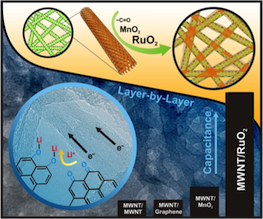 The continued evolution of portable electronic devices and micro-electro-mechanical systems (MEMS) requires multi-functional microscale energy sources that have high power, high energy, long cycle life, and the adaptability to various substrates. Nanostructured thin-film lithium-ion batteries and electrochemical capacitors (ECs) are among the most promising energy storage devices that can meet these demands.
The continued evolution of portable electronic devices and micro-electro-mechanical systems (MEMS) requires multi-functional microscale energy sources that have high power, high energy, long cycle life, and the adaptability to various substrates. Nanostructured thin-film lithium-ion batteries and electrochemical capacitors (ECs) are among the most promising energy storage devices that can meet these demands.
Shao-Horn and Hammond have developed binder-free, carbon-based nanostructured electrodes prepared from a layer-by-layer assembly process, that provide enhanced gravimetric and volumetric energy for capacitors and enhanced power capabilities for batteries. Based on promising findings for thin electrodes of several microns in thickness, these new electrodes could also potentially be envisioned for portable electronics, electrified transportation, and load-leveling applications if successful scale-up to tens or hundreds of microns can be achieved.
Image: Novel electrode system includes: nanostructured carbon electrodes with an interpenetrating network structure which can facilitate electron and ion transport, and surface redox active species such as oxygen functional groups, MnO2 and RuO2 nanoparticles that provide enhanced charge/energy storage.